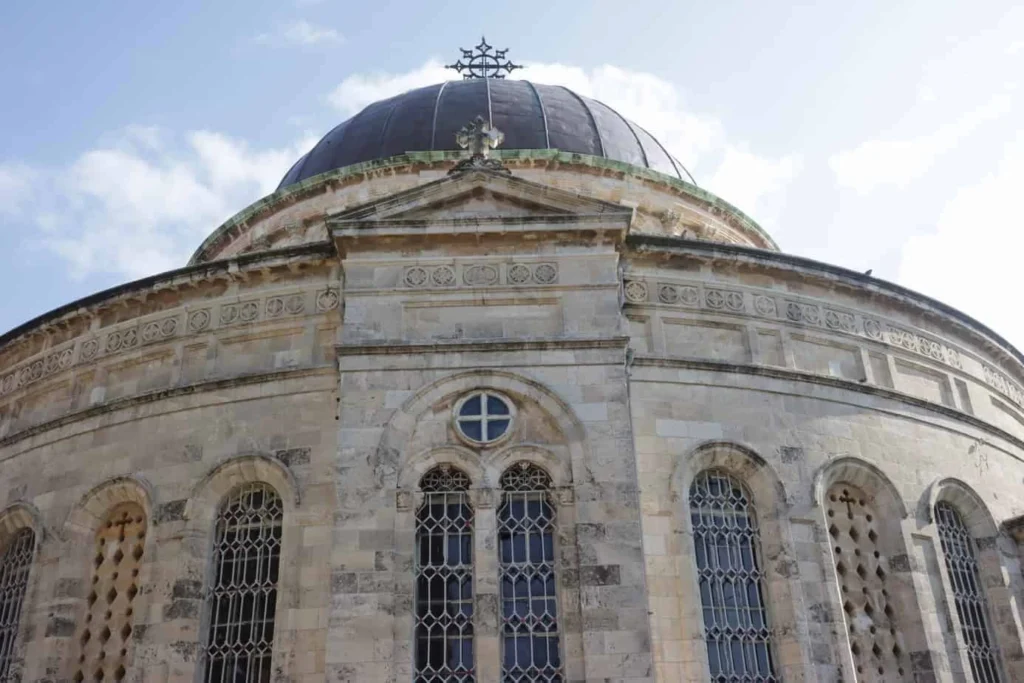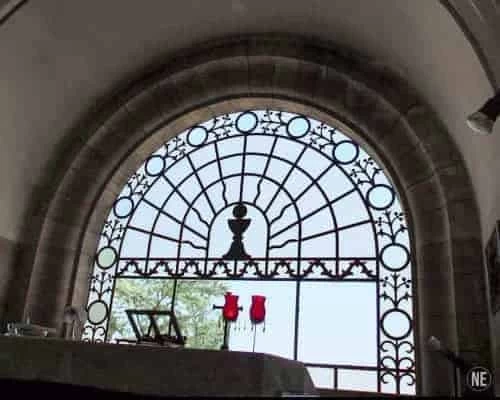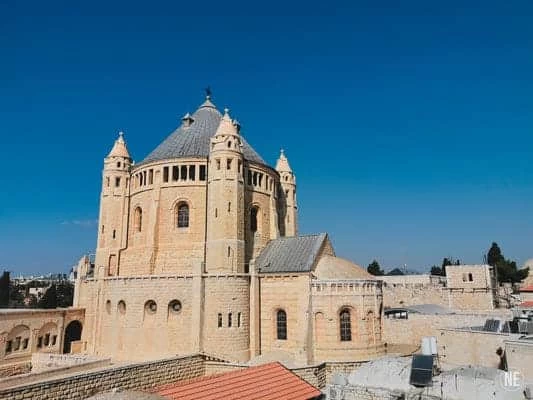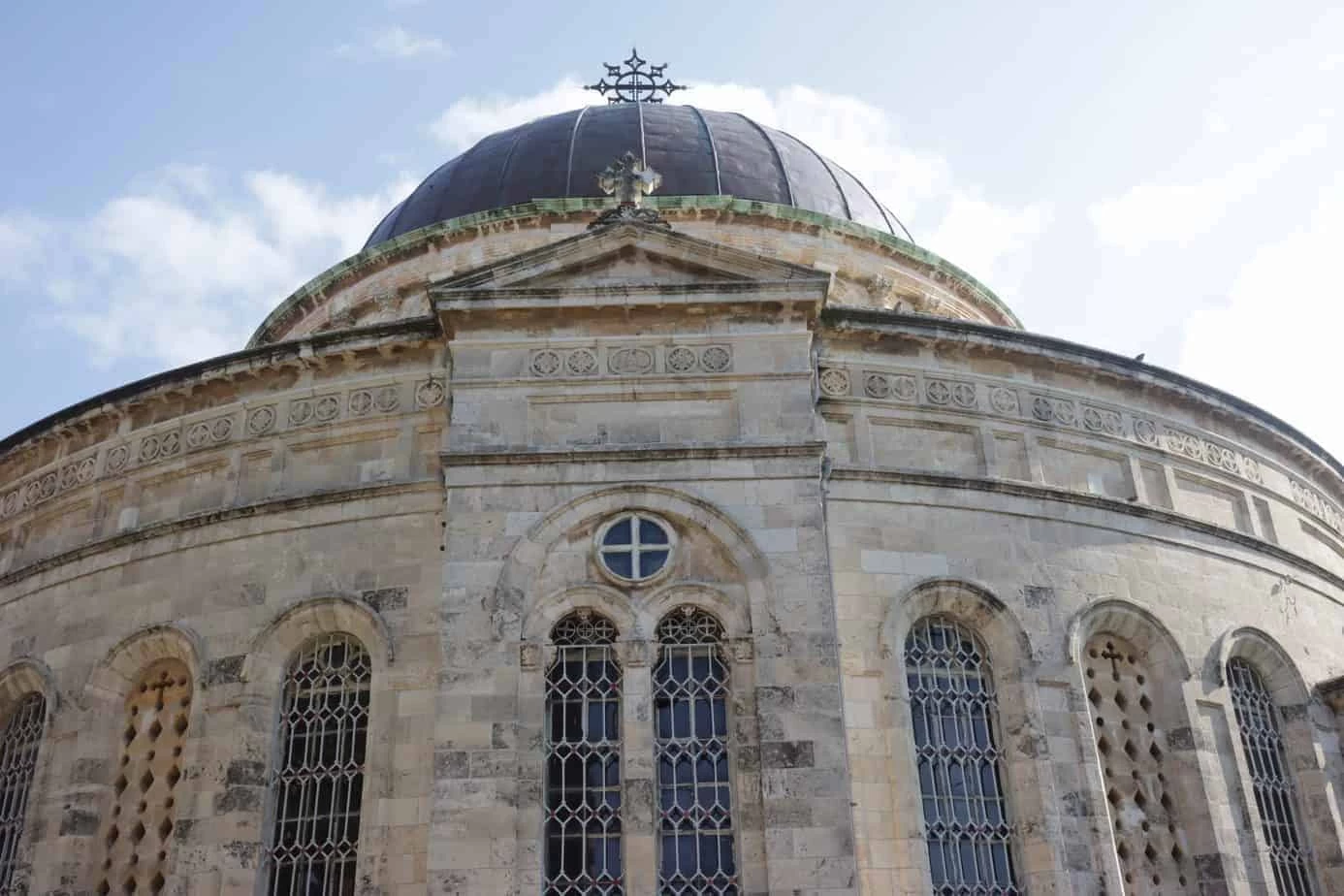In the middle of the holy city of Jerusalem, there is an unfamiliar secret place. Walking down Ethiopia hidden street until you reach a metal door and look up, you will see an Amharic inscription and two reliefs of lions smiling at you and holding a flag, this is the place.
Go into the gate, but be careful not to stumble from the gate entrance. You will see a large circular structure—the Ethiopian church of Jerusalem—before you. On the top, we find a round metal roof with the Ethiopian cross. The Ethiopians think the devil waits in the corners, so there’s no place for the devil here. The style of the structure is eclectic and combines Western design with traditional Greek design, like the pediment.
Nestled within the heart of Jerusalem lies a hidden gem waiting to be discovered. Venture down Ethiopia Hidden Street until you encounter a nondescript metal door adorned with an Amharic inscription and flanked by two smiling lion reliefs clutching a flag – this is your gateway.
Stepping through the gate, take heed not to stumble as you enter; what awaits beyond is truly remarkable. Before you stand the Ethiopian Church of Jerusalem, a grand circular structure crowned by a metal roof bearing the Ethiopian cross. Designed to ward off evil, the architecture blends elements of Western and traditional Greek styles, evident in its eclectic façade and pediment.
Known as Kindane Meheret, or the Covenant of Mercy, the church holds a special significance tied to the lost covenant of the ark, shrouded in myth and legend. Belonging to the Christian Orthodox monastery of Dovrat-Ganat, also known as the Mount of Paradise, this sacred space owes its existence to the benevolence of Ethiopian Emperor Johannes. His land acquisition from the Ottoman government facilitated the church’s construction, marking a pivotal moment in its history and enduring legacy.
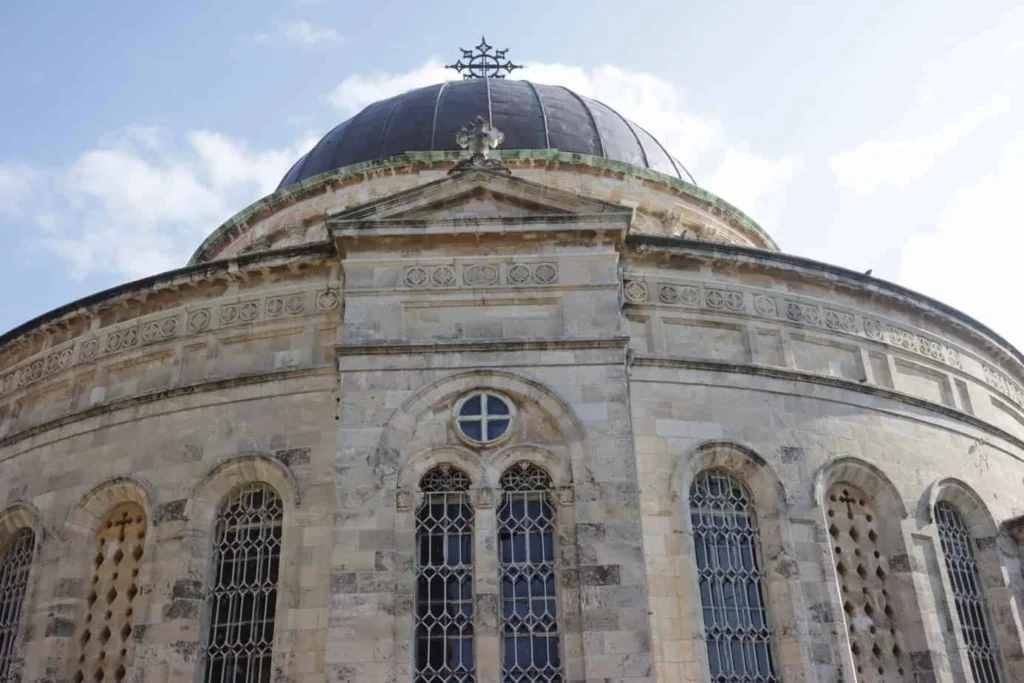
The churchyard and It’s Surrounding
As you step into the churchyard, you’ll likely encounter Christian community members relaxing on the nearby benches while children play amidst the tranquil surroundings. The church is nestled amidst community buildings, fostering a sense of unity and belonging among its members.
To the left, you’ll spot the “House of Bread,” where the sacred bread for communion ceremonies is meticulously prepared with reverence and care. On the right, a quaint building serves as a gathering space for local events and celebrations, warmly welcoming visitors with open arms.
The circular church boasts three entrances and a surrounding balcony, each designated for different purposes – one for women, another for men, and a separate entrance for clerics. Adjacent to the church stands another building, providing accommodation for community members dedicated to serving within the church’s premises.
Before we remove our shoes and step inside this hallowed sanctuary, we must ask why a street named Ethiopia exists in the heart of Jerusalem alongside an Orthodox church dedicated to Ethiopian Christians.
The story of the Christian Ethiopians and their former ancestor, King Salomon.
As you step into the churchyard, you’ll likely encounter Christian community members relaxing on the nearby benches while children play amidst the tranquil surroundings. The church is nestled amidst community buildings, fostering a sense of unity and belonging among its members.
To the left, you’ll spot the “House of Bread,” where the sacred bread for communion ceremonies is meticulously prepared with reverence and care. On the right, a quaint building serves as a gathering space for local events and celebrations, warmly welcoming visitors with open arms.
The circular church boasts three entrances and a surrounding balcony, each designated for different purposes – one for women, another for men, and a separate entrance for clerics. Adjacent to the church stands another building, providing accommodation for community members dedicated to serving within the church’s premises.
Before we respectfully remove our shoes and step inside this hallowed sanctuary, it begs the question: why does a street named Ethiopia exist in the heart of Jerusalem alongside an Orthodox church dedicated to Ethiopian Christians?
Keepers of the Convent Ark
Many believe the lost Jewish covenant ark may still exist in Axum, Ethiopia, purportedly housed within the local St. Mary of Zion church, specifically within the Chapel of the Tablet. Access to this sacred space is restricted, with only a designated guardian permitted to enter, dedicated to safeguarding this revered artifact. As a result, Christian Ethiopians regard themselves as the custodians of the lost covenant ark.
The significance of St. Mary of Zion extends beyond its potential connection to the ark, holding profound importance for Christian Ethiopians. It is a site steeped in tradition, revered as the traditional location for the coronation of Ethiopian emperors, adding to its spiritual and cultural significance within the community.
Remove your shoes before entering the church; this is a sacred place.
Inside the Church
The first thing you will notice when entering the church is the many pictures of Jesus and Maria. However, they are not the Western Orthodox pictures you are used to seeing in Orthodox churches. Now, Jesus and Maria have an Ethiopian look.
You have a round corridor in front of you and a square structure known as the Holy of Holies, the “Maqdas.” It symbolizes the holy place inside the Jewish Temple (Maqdas is a similar word to a temple in Hebrew). This is where the celebration of communion takes place. Above, you will find an explanation of the church in Italian, French, Arabic, and the local Amharic language on either side.
The ceiling, painted in pastoral colors with angel drawings, creates a calm atmosphere and helps with prayer and meditation.
Along the circular corridors, you will also find the Kebero, a traditional Ethiopian goat leather drum. It is used for ceremonies and symbolizes the beaten body of Jesus.
There is also a T-shaped walking stick known as Debtera. It’s the prayer stick. It is used as a support stick for the priest during long ceremonies, to tap on the ground, and to make a rhythm in prayer.
The Ethiopian and Christianity
The Ethiopian nation is the second nation after the Armenian nation to convert to Christianity during the fourth century. The Christians in Ethiopia are mostly Orthodox (Tewahedo church).
There is a traditional story about the way Christianity arrived in Ethiopia.
According to the story, two Syrian brothers sailed a boat that was swept away to Ethiopia. They were appointed to positions in the king’s court as they were educated. One day, one of the brothers went to Alexandria (today’s Egypt) as part of his job and met with the local bishop. He told the bishop that there are only a few Christian members in Ethiopia, but they have no church to pray at. The bishop was impressed with him and decided to appoint him as the bishop of Ethiopia. This caused a strange situation in which the Egyptian Copts appointed an Ethiopian Christian religious leader without knowing their language.
Christian Ethiopians and Judaism
There are many Traditions held by Ethiopian Christians which are similar to Judaism traditions, such as:
1] Observance of Shabbat. The Christian Ethiopians do not work on Shabbat and use this day as their day off.
2] Food restriction: they eat only kosher food.
3] Practice circumcision.
4] Keeping some of the Jewish feasts.
Maybe you know this place for the movie?
Part of the epic movie Exodus, released in 1960 and starring Paul Newman, was filmed just here, in the Ethiopian church courtyard.
The History of the church
On the entrance wall leading to the churchyard are two reliefs of Ethiopian lions holding a Christian cross and wearing a crown. Next to the lions is written in the Ge’ez language (the Ethiopian sacred language): “The lion of the tribe of Judah, Menelik the second, king of the kings of Ethiopia, won in 1889.” This indicates that the church was established in 1889. The church named Dovrat-Ganat, Mount of Paradise was built thanks to the Ethiopian emperor Johannes, who bought the land from the Ottoman government to get outside of the old city walls. That is why, in the same area, you will find more buildings belonging to the Ethiopian Christian community, such as the house of the Ethiopian consul.
The Christian Ethiopians came to Jerusalem in the 15th century. During the Ottoman period, their power weakened, and many left for Ethiopia. Upon their return, they discovered that others had taken their territory in the Christian Quarter in the old city. Having no choice, they sat on the roof of the Church of the Holy Sepulcher. To this day, Deir El Sultan is known as the Monastery of Solomon, named after King Solomon and located on top of the Holy Sepulcher church.
Travel Information
This street is full of gorgeous historical buildings such as The Ethiopian Consulate building on Ha-Nevi’im 40 Street and the German Hospital (former Bikur Holim Hospital) on Haneviim 51 Street, and many more. In general, walking around this church will make you feel as if you returned to the beginning of the 20th century.
Address: Ethiopia 10. Street, Jerusalem
Arrival options
| Bus Lines | From Jerusalem Centre bus station to Hanevi’im and Harav Kook corner: Line 17,18, 19, 51, 86 |
| Light Train | You can take the train to “Yitchak Navon” Station in Jerusalem. Then, cross the road to the Central bus station or the light train and continue until you reach Hanevi’im Street. |
| Israeli National Train | You can take the train to “Yitchak Navon” Station in Jerusalem. Then, cross the road to the Central bus station or to the light train and continue until you reach Hanevi’im Street. |
Accessibility
The church is not suitable for wheelchairs as it has steps and a narrow entrance.
Weather/Clothing
Since this is a sacred place, one should dress respectfully. Avoid shorts, short skirts, and tank tops.
Jerusalem is considered cold during the winter, so bring a jacket.
Add this place for your next visit to Jerusalem.
If you are looking for a magical place, the locals don’t know about; this is it.
Upon my first visit to this church, I was captivated by the unique atmosphere and intrigued by the rich traditions of the Ethiopian Christian community.
The church’s architectural beauty immediately caught my eye, and stepping inside, I was immersed in the practices of Ethiopian Christian Orthodox worship. The striking parallels between the customs of Judaism and the Ethiopian Christian narrative surrounding the Ark of the Covenant raise compelling questions about their historical connection to King Solomon. Could the enduring tale of the lost Ark finding its home in Ethiopia hold some truth?

